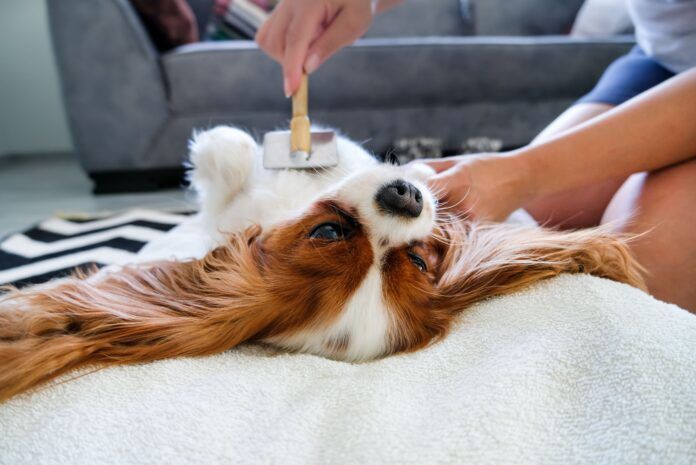Beyond just saving time and money at the groomer, doing some of your dog’s grooming at home can provide the opportunity to keep an eye on her overall health, spend time together, and work on any discomfort or anxiety she might have about grooming. While it can seem daunting at first, learning the basics of how to groom a dog is well within reach for many dog owners. Maintenance tasks like bathing, brushing coats and teeth, and trimming nails are a great place to start.
How to Groom a Dog at Home
When it comes to how to groom a dog at home, there are a few tools you will need for the job. Some things, such as what kind of brushes you will need, will depend on your dog’s coat type. The basics include:
- Nail clippers and/or a nail grinder
- Brushes
- Toothbrush
- Dog toothpaste
- Dog shampoo/conditioner
There are also some items that are nice to have but not necessary such as:
- Electric clippers
- Dog blow dryer (cool air)
- Grooming table
- Shedding tools
- Spray bottle
- Bath/shower attachment
For more detailed suggestions on at-home grooming equipment, see “Supplies for Dog Grooming at Home.”
Grooming Anxiety
Before getting into how to groom a dog, it’s important to note that grooming should be a relaxed, stress-free process for both you and your dog. If your dog is anxious about being groomed—or even just inexperienced—you will need to develop a training plan to help her figure out that it’s not so scary after all. Remember that forcing her will often just frighten her more and make the process far more difficult in the long run.
If your dog struggles to stay calm for grooming, it often helps to practice beforehand using high-value rewards. Break the process down into easily attainable steps, keep the experience positive, and be prepared to practice daily. Above all, be patient and don’t be afraid to contact a good, fear-free trainer for help.
For further information on how to teach a dog to be calm for grooming, see “Tips For Grooming An Anxious Dog.”
Brushing Your Dog
The goal of brushing your dog is to remove loose hair, tangles, and debris from her coat. Brushing also helps distribute the natural oils in the coat and stimulates the skin, which helps to keep both healthy. Because of this, even short-haired dogs should be brushed weekly. Dogs with longer hair, curly or double coats (dogs like Huskies that have both an undercoat and topcoat) may need to be brushed daily.
The first step when brushing a dog is to pick the right brush for your dog’s coat. For single-coated dogs with shorter hair, try a slicker brush, bristle brush, or silicone grooming glove. In addition to slicker and bristle brushes, tools that are useful for double-coated or long-haired dogs include rubber or plastic currycombs, pin brushes, and undercoat rakes.
There are several things to keep in mind when brushing your dog:
- There is no right or wrong place to start. Some people begin brushing at the dog’s head and work back to the tail while others do the reverse. Pick what’s comfortable.
- When brushing, use gentle, firm strokes that get down to the skin but don’t scratch it.
- Follow the direction of the dog’s hair.
- Avoid brushing directly over sensitive areas such as eyes, noses, and genitals.
- Take breaks if needed.
- Go slowly to keep from tugging on any tangles or mats.
It’s important not to pull on any tangles or mats you find as this can be painful for the dog and may even damage the skin. If necessary, use a detangling product (follow directions on the label) and gently work to untangle the hair. In some cases, mats may need to be cut out with electric clippers or scissors. If you are not comfortable doing so, seek help from a professional groomer.
For more on how to choose the right brushes, see “Brushes and Tools for Shedding Dogs.”
Bathing a Dog at Home
You don’t need a professional grooming tub to give your dog a good bath. Depending on the size of your dog, a sink, bathtub, or shower will do. If it’s warm enough, you can also head outside and use a wading pool or hose. Anywhere that has access to warm (avoid hot or cold) water and can comfortably fit the dog is fair game.
Once you’ve selected a spot, gather your tools—you’ll need a brush, shampoo, conditioner (if wanted), and towels or a hair dryer. From there:
- Brush your dog thoroughly
- Wet with water
- Work shampoo into coat, avoiding eyes and ears
- Rinse
- Apply conditioner
- Rinse
- Dry your dog
- Brush while drying
Make sure the products you are using are gentle enough that they won’t irritate your dog’s skin. If you are looking for alternatives to commercially available products, you can also make your own dog shampoo.
For step-by-step instructions and bathing product suggestions, see “How to Bathe Your Dog.”
Trimming Nails
Why are nail trims so important? Over time, too-long nails can actually compromise a dog’s weight distribution and natural alignment, causing pain and making the dog more susceptible to injury, or even curve around and grow into the pad of the foot. The good news is that those issues are easily avoided with regular nail trims.
The most common methods for trimming dog nails use nail clippers, nail grinders, or a combination of both. There are also scratch pads available, which use abrasive material to help keep nails short.
Nail trimming is often a dog’s least favorite grooming task. As mentioned in the section on grooming anxiety, you will need to be prepared to work with your dog to make it a tolerable process for her. Also, if you choose to use a nail grinder, your dog will likely need time to get used to the sound. To help her, give her treats while it is running, first a few feet away and then, once she is comfortable, held close to her paws.
To trim a dog’s nails with clippers:
- Tuck back any loose hair so you can clearly see the nail.
- Identify where you are going to cut. For white nails, avoid the pink “quick” down the middle of the nail and just cut in solid white. For black nails, focus on the tapered part of the nail and not the wide base.
- Clip in one smooth steady motion.
- Praise and reward your dog.
- Trim sharp edges if using scissor-type clippers or use a nail grinder to smooth them down.
To trim a dog’s nails with a grinder:
- Once your dog is acclimated to the grinder, hold the grinder at a 45-degree angle to the nail.
- Apply light pressure so it files the nail back.
- Repeat on the other side of the nail to even it out.
- Smooth out any rough or sharp spots so the nail tip is rounded.
For further information, see “How to Trim Dog Nails.”
Cleaning Teeth
At-home dental care for dogs is often overlooked but is extremely important for combating periodontal disease—alongside regular veterinary checkups and professional dental cleanings. While brushing your dog’s teeth daily is ideal, even just three times a week has been shown to be beneficial. As with other grooming tasks, you’ll want to start slow when getting your dog used to having her teeth brushed and keep the experience positive.
Begin by just running your finger or a soft, damp washcloth over the outer surfaces of your dog’s front teeth. Once she gets used to that, move to the outer surfaces of the back teeth and then to the inner surfaces. When your dog is comfortable with having all of her teeth touched, introduce a toothbrush followed by dog toothpaste.
When picking dental hygiene items for your dog, it’s best to get a toothbrush either made specifically for dogs or one made for human babies. Also, dog-specific toothpaste is a must. Human toothpaste as it is not designed to be swallowed and may not be safe for a dog’s gastrointestinal tract. If your dog won’t tolerate having her teeth brushed, there are options in the form treats, chews, and food/water additives that can help.
For more on how to care for you dog’s teeth at home, see “At-home Dental Care for Dogs.”
Haircuts
Giving your dog a haircut is one of those areas where it’s usually best to at least consult a professional groomer before trying it out at home. There are a lot of things to watch out for that, if you are new to dog grooming, can be a struggle to get right. Mistakes can be uncomfortable or even painful for your dog.
Adding to the complication, different coat types need to be handled in different ways. While some dogs do best with regular shaving, some—such as most double-coated breeds—shouldn’t be shaved at all except in special circumstance. A groomer will be able to advise you on what haircut, if any, would be best for your dog.
If you do decide to try cutting your dog’s hair at home, make sure she is able to stand calmly while being groomed and is comfortable with the sound and feel of electric clippers or scissors. Before getting started, familiarize yourself with your dog’s anatomy so you don’t end up accidentally hurting or cutting her—even electric clippers can snag a nipple or burn sensitive skin if handled incorrectly.
None of this is meant to imply you can’t learn if you want to! Just use caution and get someone knowledgeable to teach you first.






